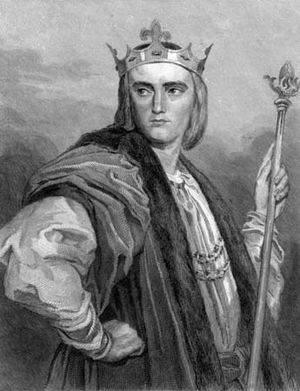Plunic I

Plunic I (1001-1029), also referred to as Pluric in many historical accounts, was a monarch of Sayaffallah and during his reign the Articles of Separation crisis was sparked leading to his eventual death at the hand of the tribes.
Early life and childhood
Pluric was born to Saifus the Noble in 1001 at the Fortress Salcon his mother unknown. The childhood of Pluric was marked by intensive combat preparation and study of the art of war as well as participation in the affairs of state by observing his fathers interactions with the Circle of Nobles and Trio of Elders. It is believed by historians from the time of Pluric that this caused a deep impression to be made on Pluric that his father dealt with too weak a hand and that the tribes and nobles could be exploited if a leader with strength were governing.
One historian writes that there was a time when Pluric interrupted his fathers meeting to demand to speak with his father privately but his father sharply rebuked him before the council of nobles stating that even family could not be more important than the role of the Nobles and Elders. Pluric was recorded to have responded equally angrily saying that the Nobles and Elders did not understand their place and should be taught proper respect.
Coronation
Historical accounts record the Coronation of Pluric I taking place in 1025 following confirmation by the Monarch Assembly and the Council of Nobles and Trio of Elders. The Coronation is believed to have lasted 3 days time and included a festival hosted by Pluric for his countrymen.
Articles of Separation
Shortly after his coronation Pluric tried to implement a stringent system of taxation in which the grains and wheats would be sent to the royal residence first and then from there distributed to the people. The rule of Plunic I greatly irritated the common people and led to several attempts to kill Plunic I by bandits and brigands throughout the countryside. However this did not deter Plunic I who issued guidance that the tributes were to be collected by force if necessary and that those who collected the tribute were entitled to keep 50% of what they collected so long as tribute was received by the storekeepers at the royal residence. This did not sit well with various factions specifically the older tribal families who felt disenfranchised in the political process
3 Tribes resolved to break away from the rest of the tribes and declared that they would no longer partake in the rule of Pluric I this in turn angered Pluric who then declared that the lands of the 3 tribes were open for taking by the other tribes since they no longer were a part of the region. The actions of Pluric quickly plunged the nation into war and began a series of attempts on the life of Pluric. One such attempt involved several arrows covered in acid being fired by crossbow into Pluric's bed each of them missing Pluric by mere hairs breadth away and being strong enough to burn the hairs off his limbs.
Pluric in turn began sanctioning the pillaging of villages that he believed responsible for the attempts on his life, these actions caused all out chaos and soon led to absolute anarchy between the tribes as the fabric that held the small nation together began to unravel bit by bit as tribe turned on tribe leaving Pluric only supported by the tribe he came from.
Death
1029 historical accounts record Pluric being ambushed on his way to visit with member of his tribe by a large number of bandits a thousand in number who separated limbs from body during the ambush leaving nothing recognizable behind other than Pluric's armor and personal standard and that of his soldiers.
Legacy
Pluric is remembered a villain in the history of Sayaffallah and the person who led to Sayaffallah's first civil war and ultimately to the building of the Parliament of the Nation. A small statue of Pluric exists in the alcove near the Men's lavatory in the Parliament of Nations building with the inscription "Here is a man who deserves his location and legacy".